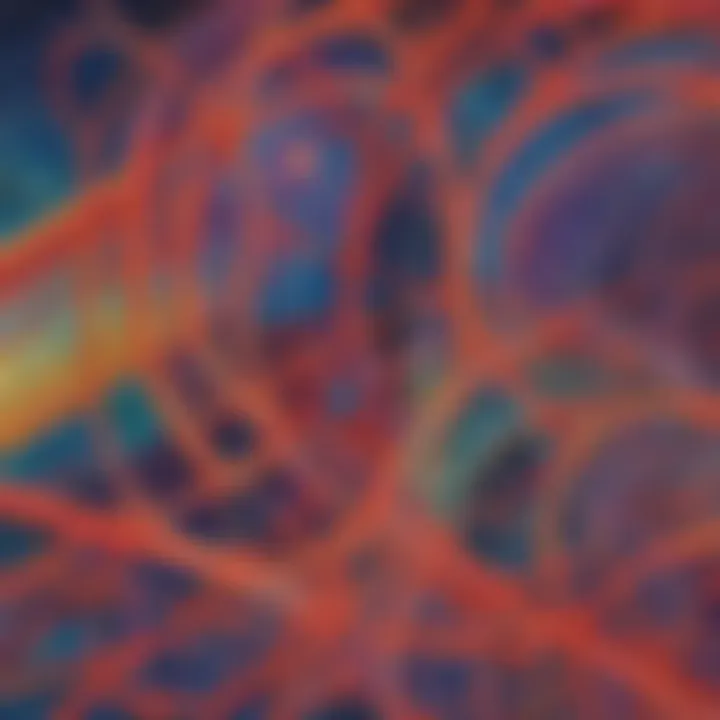Understanding Parallels: A Comprehensive Exploration


Intro
The concept of parallels transcends simple geometry. It has deep implications in various fields, ranging from mathematics to philosophy. Understanding parallels involves recognizing their definitions and connections. This article will offer clarity on this multifaceted term.
At its core, parallels refer to lines, paths, or ideas that never meet, no matter how far they extend. In mathematics, particularly in the study of Euclidean geometry, parallels retain specific properties that can influence various computations and theorems. Additionally, the idea of parallels extends into abstract realms, such as comparing similar concepts in literature or social science.
Exploring this topic benefits not only students and educators but also anyone with curiosity about systems, structures, and their relationships. By breaking down the fundamental properties of parallels, we aim to impart a comprehensive understanding that extends beyond the classroom.
Creative Activities
Engaging with the concept of parallels can be interactive and enjoyable, especially for children. Creative activities can serve as powerful learning tools, allowing young minds to grasp abstract concepts through hands-on experience.
Craft Ideas
Here are some craft ideas that children can easily replicate to explore parallels:
- Parallel Art: Using colored pencils or markers, children can draw parallel lines across paper, experimenting with colors and thicknesses.
- Build Models: Create models using straws or sticks arranged in parallel formations to visualize the concept in three dimensions.
- String Games: Using string, children can make parallel patterns by anchoring one end and stretching it out in parallel lines.
Step-by-Step Guides
1. Parallel Art
- Take a blank sheet of paper.
- Choose two colors of pencils or markers.
- Draw one straight line with the first color.
- Use a ruler to draw another line with the second color, ensuring it stays parallel to the first line.
- Continue to add more lines, alternating colors as desired.
2. Build Models
- Gather straws (or sticks) and scissors.
- Cut the straws into varying sizes but keep a few the same length.
- Arrange the straws in parallel lines on a flat surface and secure them with tape.
Educational Value
Participating in these activities reinforces the concept of parallels in a fun and engaging way. Children learn spatial awareness, develop fine motor skills, and understand the importance of maintaining distance between parallel lines. These crafts also foster creativity while solidifying knowledge.
Fun Quizzes
Quizzes can be an enjoyable way to test understanding and reinforce learning about parallels. A variety of topics can be covered through interactive questions.
Quiz Topics
- Properties of parallel lines in geometry.
- Real-world examples of parallels in architecture.
- The significance of parallels in literature and art.
Question Types
To keep children engaged, quizzes can consist of:
- Multiple-choice questions.
- True or false statements.
- Fill-in-the-blank prompts.
Knowledge Reinforcement
Quizzes provide an excellent opportunity for children to assess their understanding of parallels. They can identify gaps in knowledge and revisit the material, leading to improved comprehension.
Fact-Based Articles
Fact-based articles deepen understanding through informative content.
Topics
Various article topics may cover:
- The mathematical definition of parallel lines.
- Historical usages of the concept of parallels in different cultures.
- Applications of parallels in modern technology.
Engaging Content
The information is presented simply yet effectively. By using clear language and illustrations, articles keep readers' interest and make complex ideas more approachable.


Defining Parallels
Defining parallels is a fundamental step in understanding their significance across various domains. The concept lays the groundwork for both mathematical theories and real-world applications. By clarifying the definition, we can explore the detailed characteristics that make parallels unique and vital to many fields. Recognizing parallels encourages a deeper comprehension of relationships within geometry and other contexts.
A Fundamental Definition
At its core, a parallel refers to entities that maintain a consistent distance apart and never converge. In geometry, this generally applies to lines that lie in the same plane and are equidistant at all points. To say two lines are parallel is to assert that they do not intersect. This definition, while straightforward, serves as a gateway into more intricate discussions regarding how parallels function within spaces and frameworks.
Mathematical Perspectives
From a mathematical viewpoint, parallels are essential in the study of geometry and more complex mathematical structures. In Euclidean geometry, the concept is captured by postulates stating that through a point not on a given line, there exists exactly one line parallel to the given line. This notion not only shapes proofs and theorems but also influences various applications, including coordinate geometry. Here, the slope of parallel lines remains constant, critical for understanding graph functions and linear equations.
Non-Mathematical Contexts
Outside the realm of mathematics, parallels find relevance in multiple disciplines. For instance, in philosophy, parallels might refer to comparative frameworks where two theories or ideologies are assessed for similarities. In literature, authors often draw parallels between characters, themes, or plot developments to highlight essential messages. Understanding how parallels manifest in these contexts provides perspectives that inspire critical thinking. They help in comparing concepts across different spheres, enhancing our understanding of human thought and cultural expressions.
Understanding parallels allows for a clearer comprehension of relationships, whether in math, philosophy, or the literary arts.
Geometric Properties of Parallels
Understanding the geometric properties of parallels gives insight into their crucial role in various branches of mathematics. Parallels, particularly parallel lines and planes, provide a foundation for many geometric principles and theorems. They help in creating structures, solving equations, and understanding spatial relationships. This section will delve into these properties, focusing on how they are defined and utilized.
Parallel Lines in Geometry
Definition of Parallel Lines
Parallel lines are defined as lines in a plane that never meet. This means they maintain the same distance apart at all points. The significance of this definition extends to numerous applications in geometry, where these lines are foundational to concepts like slopes and angles. A key characteristic of parallel lines is their consistent separation, which allows for predictable geometric behavior. This predictability makes parallel lines a popular element within geometry studies. Notably, in coordinate geometry, parallel lines have the same slope. This feature facilitates various mathematical processes, including calculations in various proofs.
Characteristics of Parallel Lines
The characteristics of parallel lines play a vital role in diverse mathematical contexts. One of the main aspects is that they have identical angles when cut by a transversal. This quality is a crucial point in geometric proofs and theorem applications. The parallel nature of these lines means any transversal creates corresponding angles that exhibit equal measures. This characteristic promotes understanding of angular relationships, which is essential in various geometric proofs. The simplicity and reliability of these characteristics make parallel lines invaluable in mathematical reasoning and proofs.
Examples in Two-Dimensional Space
Exploring examples of parallel lines in two-dimensional space highlights their practical importance. Common instances include the edges of a rectangle or the sides of a parallelogram. Such examples illustrate the concept of parallelism vividly, as they provide visual confirmation of parallel lines’ properties. The presence of these lines in real-world objects enhances comprehension for young learners, making the abstraction of parallels more tangible. Additionally, these examples facilitate activities where students can draw or manipulate geometric shapes, further reinforcing the idea of parallel lines in a hands-on manner.
Parallel Planes
Understanding Parallel Planes
Parallel planes are surfaces that do not intersect. This concept can be understood through the idea that two planes maintain a constant distance apart. The importance of parallel planes lies in their application across different fields, including architecture and aviation. A key characteristic of parallel planes is their ability to support structural integrity in designs. For instance, parallel planes can be found in the construction of walls in buildings, ensuring stability. Understanding this concept enables learners to visualize how planes function in space, aiding in more complex spatial reasoning challenges.
Applications in Three-Dimensional Geometry
The application of parallel planes in three-dimensional geometry reveals their relevance in design and engineering. These planes are used to create frameworks and support systems in various constructions. For example, when designing a bridge, engineers often reference parallel planes for stability. Another notable application is in computer graphics, where parallel planes are essential for rendering shapes accurately. The unique aspect of three-dimensional parallel planes enhances the understanding of spatial relationships in real life. Their practical significance cannot be understated, as they contribute to the safe and efficient design of countless structures in our everyday environment.
Applications of Parallels in Mathematics
In the realm of mathematics, the concept of parallels serves critical roles in various disciplines, particularly geometry and coordinate systems. Understanding these applications is essential, as it helps illuminate the foundational structures that undergird more complex mathematical theories. Parallels are not just theoretical constructs; they have real implications in proofs, computations, and visual representations of mathematical ideas.
Geometry and Proofs
Using Parallels in Theorems
The utilization of parallels in theorems showcases their significant relevance. This concept often appears in fundamental theorems, including the Parallel Postulate, which states that through any point not on a given line, there exists exactly one line parallel to it. This principle is a touchstone for many other statements in geometry.
The key characteristic of using parallels in theorems is their guaranteed relationship; parallel lines maintain consistent distance, which simplifies calculations and proofs. It is a beneficial choice for establishing relationships between different geometric shapes. The unique feature of this aspect lies in its broad applicability. It forms the backbone of many geometric proofs, showing how varying shapes can relate to one another through parallel lines.
While strong in utility, this approach may have disadvantages; not all geometries uphold the Parallel Postulate, particularly in non-Euclidean contexts. It becomes imperative for learners to grasp when and why this theorem applies.
Proof Techniques Involving Parallel Lines
Proof techniques involving parallel lines encompass various strategies that leverage the properties of parallels to prove other statements. Here, parallels facilitate reasoning, allowing mathematicians to derive conclusions based on existing relationships. These techniques often include the use of transversal lines and angles, helping to establish congruence or similarity between figures.
The key characteristic of these techniques is their reliance on foundational geometric principles. This approach is a popular choice in geometry education, as it empowers students with logical reasoning skills while engaging with practical applications. The unique feature of using parallel lines in proofs lies in their ability to extend conclusions across multiple contexts, improving comprehension of geometric relationships.


However, one must acknowledge disadvantages—this approach can lead to oversimplification in cases where students struggle to visualize the concepts fully. It is crucial to ensure that students connect the abstract nature of proofs with their geometric interpretations.
Coordinate Geometry
Equations of Parallel Lines
In coordinate geometry, equations of parallel lines are pivotal for understanding their relationship in a Cartesian plane. Two lines are parallel if they share the same slope. The mathematical representation of this relationship is vital in solving numerous problems.
The key characteristic of equations of parallel lines is their uniform slope. This consistency makes calculations straightforward and allows for determining the equations efficiently. It is a beneficial choice for students, as it offers clear guidelines on how to construct equations based on the characteristics of lines.
A unique feature of these equations is their relevance in various real-world applications, such as in architectural planning and engineering. However, one must consider potential disadvantages; while finding slopes might seem simple, incorrect assumptions about lines can lead to errors in understanding their relationships.
Graphical Representations
Graphical representations of parallels are essential tools in conveying mathematical concepts. They visually express the relationships between lines and shapes, making it easier for students to conceptualize geometric ideas.
The key characteristic of these representations is their ability to provide immediate visual feedback, which can enhance understanding. Graphical approaches are a popular choice for teaching, as they allow learners to see how variations in one variable can affect another. The unique feature is their adaptability; different styles of graphs can illustrate the same concepts in varied contexts, which is beneficial for diverse learning styles.
Nevertheless, relying heavily on graphical representations may also present disadvantages. Without a solid understanding of the underlying calculations, students may misinterpret the graphical data. It is crucial that learners balance both visual and theoretical foundations to fully grasp parallels in mathematics.
Parallels in Other Fields
Parallels extend beyond mathematics into various disciplines. In this section, we will explore their significance in philosophical contexts and cultural domains. The understanding of parallels in these areas enhances our overall grasp of the concept. Recognizing parallels can lead to deeper insights and facilitate connections between seemingly unrelated fields. This cross-disciplinary approach adds value to our appreciation of parallels.
Philosophical Contexts
Comparative Analyses
Comparative analyses play a crucial role in examining different philosophies. This approach allows us to identify similarities and differences between philosophical ideas. It provides a structured framework for understanding nuances across diverse theories. A key characteristic of comparative analyses is their systematic nature. They help illuminate how different thinkers tackle similar problems or themes.
Using comparative analyses can enhance critical thinking. It encourages readers to understand various viewpoints. This diversity of thought can lead to a richer dialogue among philosophical traditions. However, a unique feature of this approach is its reliance on context. Without proper context, comparisons may be misleading. This limitation indicates the need for careful interpretation.
Parallel Concepts in Philosophy
Parallel concepts in philosophy offer a rich ground for exploration. This idea involves examining related themes or principles in various philosophical systems. A significant advantage of this approach is that it allows for a broader understanding of human thought. By exploring these parallels, we can grasp complex concepts more effectively.
The key characteristic of parallel concepts is their universality. Many philosophical ideas emerge across cultures and historical periods. This commonality encourages dialogues that can transcend boundaries. However, this also brings challenges. Simplifying complex ideas to fit them into parallels can lead to oversimplification. Therefore, a nuanced approach is necessary.
Cultural and Literary Parallels
Use of Parallels in Literature
Literature often employs parallels to build deeper narratives. Authors use thematic and character parallels to highlight important messages. This method enhances a reader’s engagement and understanding. A notable characteristic of using parallels in literature is their ability to evoke emotion. By juxtaposing characters or events, authors enrich their stories.
The unique feature of literary parallels is their flexibility. They can exist on multiple levels, from plot structures to character developments. This versatility can strengthen the narrative, but it may also confuse readers. If parallels are not clearly drawn, their impact may diminish.
Cultural References and Symbolism
Cultural references and symbolism further highlight the importance of parallels. They function as links to broader societal themes or values. This connection allows us to appreciate how cultures reflect similar ideas. A core advantage of integrating cultural references is the richness they bring to understanding human experiences. Parallels embedded in culture help illuminate shared values and beliefs.
The unique feature of cultural symbolism lies in its depth. Different layers of meaning can resonate with various audiences. However, the disadvantage is that reliance on cultural context can limit comprehension. Not all audiences may share the same cultural background, which potentially hinders understanding. Thus, context is vital for interpreting these parallels accurately.
Recognizing parallels across fields deepens our understanding of narratives and philosophies, inviting us to explore connections more intimately.
Real-World Implications of Parallels
The concept of parallels extends beyond theoretical discussions in classrooms and textbooks. It has significant real-world implications, affecting various fields such as architecture, geography, and navigation. Understanding these applications can lead to more effective practices and innovative solutions. The benefits of recognizing parallels in real-world contexts include improved designs, enhanced navigation systems, and reliable structural integrity.
Architectural Applications
Designing with Parallels
When architects design structures, they often utilize parallels to ensure stability and aesthetic appeal. Parallels can create symmetry and balance in architectural plans. This characteristic makes designing with parallels a favored method for many projects. It allows for clear lines and spaces that benefit both functionality and beauty.
A unique feature of designing with parallels is that it can optimize space usage. For example, parallel walls can enhance airflow and lighting within a building. However, there are disadvantages as well. Not every design necessitates parallels; sometimes, unconventional layouts may be creatively superior.


Structural Engineering Insights
Structural engineers heavily rely on parallel concepts to enhance the integrity of buildings and bridges. Parallels in engineering provide stability, ensuring that structures can withstand various loads and environmental challenges. This results in safer buildings and infrastructures.
The key characteristic of structural engineering insights is precision. Engineers use precise measurements to create parallel components. This is instrumental in preventing failure points in large structures. However, constructing with parallels can also lead to increased costs, as the precision required may necessitate advanced technology and skilled labor.
Navigation and Geography
The Role of Parallels in Map-Making
In map-making, parallels, commonly referred to as latitude lines, are crucial for depicting the Earth's surface accurately. They help in establishing coordinates necessary for navigation. The ,key feature of parallels in maps is their ability to provide a reliable framework for locating points on the globe. This has made them an essential part of geographic education and exploration.
Using parallels in map-making offers practical advantages. They facilitate the understanding of distances between locations and assist in navigation. However, one disadvantage is that flat maps cannot entirely represent the curvature of the Earth, sometimes leading to distortions.
Understanding Latitude and Longitude
Latitude and longitude intersect to form a coordinate system that is vital for navigation. Latitude lines run parallel to the equator, while longitude lines begin at the poles. Understanding these concepts is fundamental for anyone engaging with navigation tools like GPS systems.
The key characteristic of latitude and longitude is their global applicability. They are universally recognized and allow for precise identification of locations. This ability makes them an integral part of geography. A potential disadvantage is that if one does not understand this system, it can lead to navigational errors, particularly in less familiar regions.
Teaching Parallels to Young Learners
Teaching parallels to young learners is essential in developing their understanding of fundamental concepts in geometry and beyond. The topic can build critical thinking and spatial reasoning skills. When students grasp what parallels mean, they can apply this knowledge in various contexts, from mathematics to real life. It also assists in preparing students for more advanced topics in math and science.
Effective Teaching Strategies
Using Visual Aids
Using visual aids is a significant strategy in teaching parallels. Visual aids can include diagrams, drawings, and even interactive software. The key characteristic of using visual aids is that they help students better comprehend abstract concepts. For instance, when students see two parallel lines on a graph, they can understand the idea of equal distance and direction more effectively than through verbal explanations alone.
A unique feature of visual aids is their immediate impact on retaining information. Research shows that students remember visual information better than text-based information. However, one needs to use them judiciously; over-reliance may lead students to depend solely on images without developing the necessary logical reasoning.
Interactive Learning Approaches
Interactive learning approaches engage students actively in the learning process. These strategies might include group work, discussions, or hands-on activities. The main feature of this approach is its ability to involve learners in their education actively. Schools and teachers have found this method beneficial for teaching complicated concepts like parallels.
The unique aspect of interactive learning is its capacity for peer learning. Students often explain concepts to each other, solidifying their understanding while helping classmates. However, managing group dynamics can prove challenging. Some learners may dominate discussions while others might feel shy. Balancing group interactions is critical to ensure that every student benefits from this approach.
Activities for Understanding
Hands-On Geometry Exercises
Hand-on geometry exercises provide practical experience with the concept of parallels. Such activities can include drawing parallel lines with ruler or using string to demonstrate parallel planes. These exercises highlight the concept's tactile aspect. This physical manipulation can effectively reinforce understanding.
The main advantage of hands-on exercises is their ability to create learning memories through physical activity. Students who engage with materials often have stronger recall than those who only read about concepts. Still, this requires careful preparation. Not all students engage equally and monitor them to keep all involved is necessary.
Creative Projects Involving Parallels
Creative projects involving parallels allow students to explore the concept in unique ways. They might create art pieces or models that illustrate parallel lines or planes. The key characteristic of this approach is its encouragement of creativity while reinforcing geometry understanding. Projects can be highly engaging, which promotes motivation and interest in learning.
A unique aspect of creative projects is interdisciplinary connection. Students can integrate art with geometry, enriching their learning experience. However, the downside may be time-consuming. Balancing project time with curriculum requirements can be a challenge for teachers.
In summary, effective teaching strategies and engaging activities are vital for helping young learners understand parallels. These methods not only make learning interactive but also enhance retention and creativity.
Ending
In this section, we bring together the various elements discussed throughout the article. Understanding parallels is crucial for comprehending both geometric principles and broader concepts across different fields. It serves as a key element in mathematical theories, structural design, navigation, and even philosophical discourse.
Summarizing Key Points
Several significant points have emerged in our exploration of parallels:
- Definition: Parallels refer to lines or planes that maintain a constant distance apart. This fundamental definition lays the groundwork for all subsequent discussions.
- Geometric Insight: The properties of parallel lines and planes are vital in geometry. They appear frequently in the study of shapes and angles, facilitating proofs and theorems.
- Cross-disciplinary Relevance: Parallels extend beyond math into philosophy, literature, and various real-world applications like architecture and navigation.
- Educational Value: Understanding the concept of parallels is significant for young learners. Engaging methods can foster their interest in geometry and related fields.
These points underscore the multifaceted nature of parallels. They show how integral this concept is to various disciplines, encouraging a comprehensive understanding among learners.
The Future of Understanding Parallels
Looking forward, the exploration of parallels should continue to evolve. With advancements in technology and teaching methods, the potential for richer educational experiences increases.
- Innovative Teaching Tools: Incorporating visual diagrams and interactive tools can greatly enhance students' grasp of parallels in geometry.
- Interdisciplinary Approaches: Future curricula might benefit from integrating parallels into broader contexts, such as art, design, and even technology, appealing to diverse interests.
- Research and Development: Further studies into parallels can uncover new applications and connections, fostering a deeper understanding across various fields.







